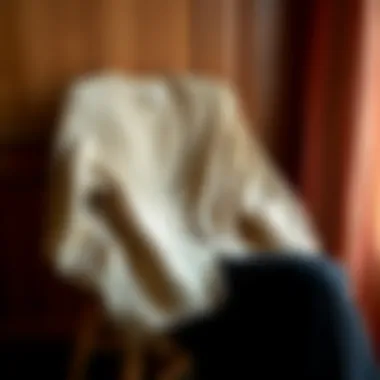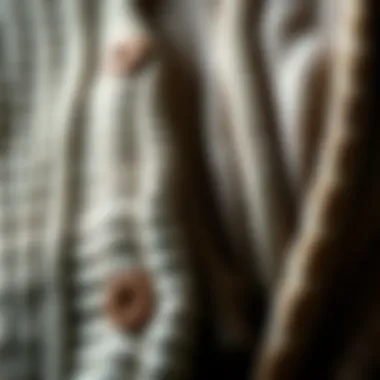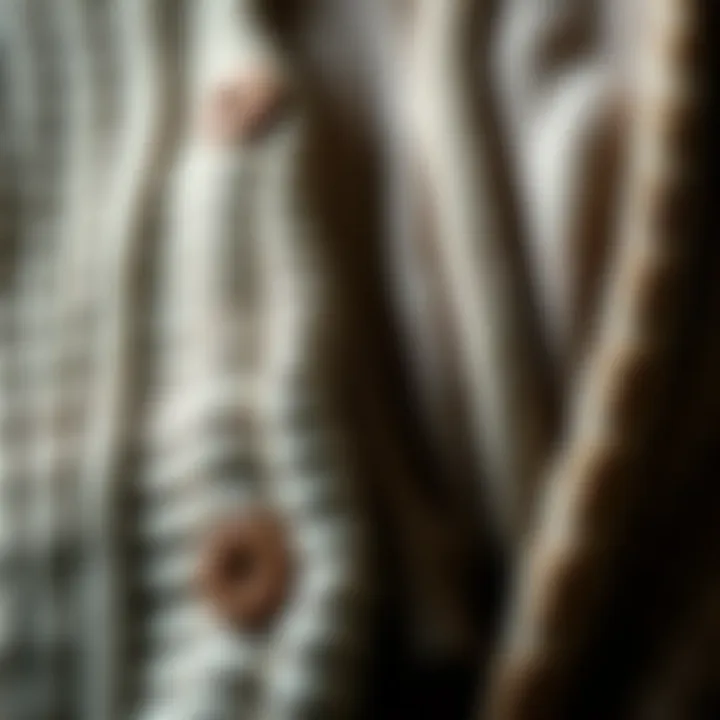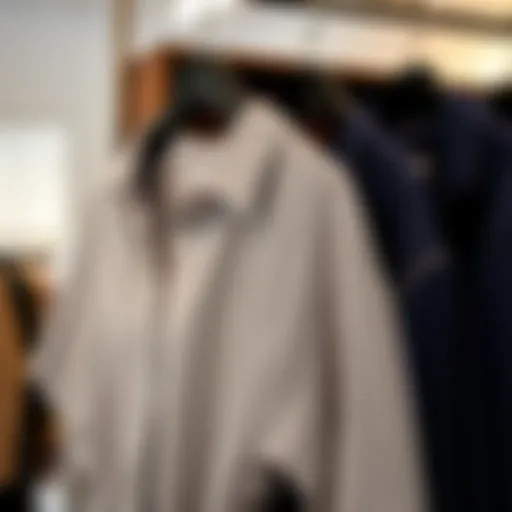The Elegant Cardigan: A Study in Style and Versatility


Intro
The cardigan is often seen as an embodiment of comfort and sophistication in the realm of fashion. With origins rooted in 19th-century British sporting attire, it has transformed over the years into a quintessential piece in both men's and women's wardrobes. Its unique blending of aesthetics and practicality positions the elegant cardigan as more than just a layering piece; it serves as a canvas that showcases personal style.
As we explore the cardigan's engagement with contemporary trends, it becomes clear that this garment is not just about warmth. Instead, it encompasses a vast spectrum that highlights individual expression while catering to practicality. It's this balance that has allowed the cardigan to flourish through the ages, adapting to the whims of fashion while remaining timeless.
In this article, we delve into the multifaceted world of cardigans, dissecting their history, varied styles, and the dynamic role they play in modern fashion. We'll address how to incorporate this piece seamlessly into both casual and formal ensembles, introduce styling tips, and examine the sustainable practices surrounding cardigan production. By the end, we aim to provide a thorough understanding of why this elegant garment holds a special place in our closets and the global fashion industry.
Fashion Trends
The tides of fashion are never still, and the elegant cardigan has successfully navigated these ever-changing currents. From the runways to streets, its presence remains strong, adapting to what’s trending each season.
Latest Seasonal Trends
This year's collections have showcased a variety of cardigan styles that cater to diverse tastes.
- Oversized fits: Those busier, relaxed styles are ruling wardrobes. An oversized cardigan can be a statement piece or a comforting hug on a chilly day.
- Bold colors and patterns: Bright hues and striking prints are in vogue. They change a simple outfit into something eye-catching.
- Textended lengths: Longer cardigans, falling below the knee, add drama, transforming traditional layering into dynamic silhouettes.
These trends reveal a desire for versatility and boldness, allowing cardigan lovers to express themselves in various ways each season.
Iconic Styles Revived
Many iconic cardigan styles are making a comeback, a testament to their endurance in fashion history. Styles like the classic V-neck or the chic shawl collar are being reimagined:
- The Preppy Cardigan: Often adorned with embroidered logos, this style harks back to academic elegance.
- Chunky Knit: A throwback to the coziness of the ‘70s, this piece brings a warmth that is both physical and nostalgic.
- The Cropped Cardigan: Recently resurfaced, this style pairs well with high-waisted trousers, a nod to vintage looks infused with contemporary flair.
The revival of these styles reinforces that what’s old can be new again, enriching the fabric of today's fashion landscape.
Style Tips
Integrating an elegant cardigan into one's wardrobe requires a little finesse. Here are some strategies to ensure it shines in any setting.
How to Mix and Match
The beauty of a cardigan lies in its versatility. Here are a few ways to mix and match:
- Layer it over: For casual outings, wear it over a graphic tee, paired with jeans and ankle boots.
- Contrast textures: Pairing a chunky knit cardigan with a satin slip dress creates an appealing contrast, allowing each piece to stand out.
- Belted look: Define your waist with a belt over an oversized cardigan to adopt a stylish silhouette while maintaining comfort.
Dressing for Different Occasions
Different situations call for specific styling approaches. Here’s how to tailor your cardigan choice:
- Casual brunch: A lightweight, button-up cardigan over a sundress is perfect for a relaxed weekend vibe.
- Office-ready: Opt for a tailored cardigan in a neutral hue that can easily pair with slacks or a pencil skirt.
- Evening out: A fitted cardigan adorned with embellishments can elevate a simple outfit, making it suitable for Cocktail hour.
By considering the occasion, you can seamlessly blend the cardigan’s style and functionality, proving it to be a truly versatile piece.
"The elegant cardigan is not just a garment; it's a statement of style and adaptability that speaks volumes through its timelessness."
Understanding the Elegant Cardigan
The elegant cardigan holds a prominent place in modern fashion, serving as a bridge between comfort and sophistication. This versatile garment has become an essential component of both casual and formal wardrobes, appealing to a wide array of individuals, from fashion aficionados to everyday wearers seeking a touch of elegance. The cardigan stands out not just for its warmth but for its ability to elevate an outfit in a heartbeat.
Historical Context
The journey of the cardigan dates back to the early 19th century when it originally emerged in Britain as a warm, knitted garment. It was named after the Earl of Cardigan, who was known for his military exploits during the Crimean War. Initially designed for comfort, the cardigan transformed over the decades, embraced by various subcultures and fashionable elites alike. For instance, the Bohemian artists of the 20th century adopted it as a symbol of laid-back chic, while Hollywood stars integrated the cardigan into their glamorous wardrobes, cementing its status as a fashion staple. This rich history not only showcases its evolution but also reflects societal shifts in taste and practicality.
Defining Elegance in Fashion
Elegance, often perceived as a blend of simplicity and sophistication, is intrinsic to the allure of the cardigan. An elegant cardigan usually features clean lines, high-quality fabrics, and thoughtful details like fine buttons or delicate stitching. Its charm lies in its ability to flatter a variety of body types while providing ample coverage and comfort. When considering elegance, one should focus on how a cardigan can be styled in various ways — from pairing it with tailored trousers for a polished look to draping it over a casual sundress, creating a versatile aesthetic that suits numerous occasions.
Cultural Variations
Fashion reflects cultural diversity, and the cardigan is no exception. Variations of the cardigan exist around the world, each bringing its flavor to the garment. In Japan, for instance, the kimono cardigan integrates traditional motifs and fabrics, blending heritage with contemporary flair. In Scandinavia, the Norwegian cardigan showcases intricate patterns and woolen textures, tailored for warmth in chilly climates. These regional adaptations not only highlight the cardigan's flexibility but also demonstrate how fashion can transcend borders and embrace local traditions. Each culture enriches the cardigan's narrative, showcasing its universal appeal while celebrating unique stylistic expression.
The elegance of a cardigan is not merely in its fabric or design; it is in its storytelling — how it connects cultures, generations, and personal styles.
By comprehending the nuances associated with the elegant cardigan, one not only appreciates its aesthetic qualities but also its historical significance and cultural richness. Understanding this garment in its entirety fosters a deeper connection to fashion, allowing savvy stylist, designer, or marketer to select or promote cardigans that truly reflect the essence of elegance and versatility.
Types of Elegant Cardigans
Understanding the types of elegant cardigans is essential for anybody looking to elevate their wardrobe. Cardigans come in a plethora of designs, styles, and materials, making the selection process both exciting and somewhat overwhelming. These variations are not just about aesthetics; they also play a significant role in comfort and versatility. By recognizing the distinct forms available, one can better match a cardigan to their personal style, body type, and occasion.
Classic Styles


Classic cardigans are the timeless pieces that have stood the test of fashion’s ever-changing tides. Typically characterized by their button-down front and comfortable fit, these styles often feature a V-neck or round neck.
- Benefits: They can be easily layered over shirts, dresses, or even turtlenecks. The classic cut flatters a range of figures, making it a popular choice for many. Often made from wool or cotton blends, these cardigans also provide warmth without sacrificing style.
- Considerations: When selecting a classic cardigan, pay attention to the fit. A tailored look can add a touch of sophistication, whilst an oversized style offers a cozy vibe. Details like pockets or ribbed cuffs can enhance the traditional design and make it all the more functional.
A quintessential piece in any wardrobe, classic cardigans are suitable for a wide array of settings, from casual outings to more formal occasions.
Modern Interpretations
As fashion evolves, so too do cardigans. Modern interpretations introduce a fresh take on the classic silhouette, often incorporating asymmetrical cuts, bold colors, and unique textures. These styles may stray from traditional fabrics and feature materials like blended synthetics for added stretch.
- Benefits: The modern cardigan often prioritizes statement-making designs which can elevate even the simplest of outfits. They tend to add an element of creativity and flair, making them perfect for those looking to make a bold fashion statement.
- Considerations: When exploring modern designs, consider how they will fit into your existing wardrobe. While vibrant colors and unusual shapes can be eye-catching, ensure they harmonize with the other pieces you own.
These cardigans often embody trends, appealing particularly to younger audiences and style adventurers who wish to break free from conventional fashion rules.
Layered and Long Variants
Layered and long cardigans are particularly popular for their practicality and versatility. These styles typically extend beyond the hip, allowing wearers to play with layering different garments underneath. Often made from lightweight materials, they can be worn year-round.
- Benefits: Long cardigans provide a flowing silhouette that can elongate the body and be a chic wrap for cooler weather. They can be paired with fitted jeans for a balanced look, or even styled over a maxi dress for an effortlessly elegant ensemble.
- Considerations: While styling long cardigans, be mindful of proportion. It’s important to pair them with clothing that won’t get lost in their length; a fitted top or tailored pants can help maintain a polished appearance.
Layered cardigans can also be a blank canvas for personal style—add a scarf, belt, or bold footwear to create a unique look.
In Summary: Cardigans, in their various forms, offer a wealth of styling opportunities. Whether classic, modern, or long, each type has essential qualities that can enhance anyone’s wardrobe. Understanding these styles empowers you to select pieces that resonate not only with your fashion sense but also with different occasions you encounter. This versatility is what makes the elegant cardigan a staple in many wardrobes.
For a further exploration into the world of cardigans, consider visiting Wikipedia or Britannica.
Whether you’re dressing for a casual lunch, a professional meeting, or even an evening out, there’s a cardigan style that fits the bill.
Material Composition
Understanding the material composition of elegant cardigans is crucial. The fabric not only influences the appearance of the garment but also its comfort, durability, and suitability for different occasions. As consumers become more knowledgeable and conscious of their clothing choices, it is paramount for designers and makers to consider how the materials they use not only affect the wearer's experience but also the environment.
Natural Fibers and Their Benefits
Natural fibers such as wool, cotton, and cashmere have a number of advantages that make them standouts in the world of cardigans.
- Breathability: Natural fibers allow air to circulate, helping to regulate body temperature. This characteristic makes cardigans made from these materials a great choice for layering.
- Comfort: The softness of wool or cashmere feels wonderful against the skin. Many people find synthetic materials uncomfortable, especially in close-fitting garments like cardigans.
- Moisture Absorption: Natural fibers can absorb moisture, which can help in wicking perspiration away from the body. This is particularly valuable for transitional weather when you might be in and out of different environments throughout the day.
- Sustainability: While this can depend on how the material is sourced, natural fibers are often more eco-friendly than synthetics. They are biodegradable and, when produced responsibly, have a lower environmental impact.
Overall, cardigans crafted from natural fibers not only provide aesthetic appeal but also ensure functionality in everyday wear.
Sustainable Fabrics
As consumers and industries alike shift toward sustainability, the type of fabric used in cardigans is becoming more important than ever. Sustainable fabrics can include organic cotton, Tencel, and recycled polyester, each offering various benefits:
- Organic Cotton: Grown without harmful chemicals or pesticides, organic cotton preserves the health of ecosystems and farmers. It helps reduce soil degradation and uses less water than conventional cotton.
- Tencel (Lyocell): Made from sustainably sourced wood pulp, Tencel is not just biodegradable but also produced through a closed-loop process that recycles water and solvents. This makes it a fantastic choice for eco-conscious consumers.
- Recycled Polyester: Often derived from post-consumer plastic bottles, recycled polyester diverts waste from landfills, reducing the overall carbon footprint of clothing production.
By opting for cardigans made from these sustainable materials, consumers contribute to environmental preservation while still ensuring they look stylish.
Care and Maintenance of Fabrics
Proper care and maintenance of cardigans extend their lifespan and maintain their elegant appearance. Here are several guidelines that can help with fabric upkeep:
- Washing: Always check the care label. Most natural fibers prefer gentle washing in cold water. Hand-washing is ideal, especially for delicate wool or cashmere cardis. If using a machine, consider a gentle cycle and a garment bag to protect the fabric.
- Drying: To avoid shrinkage, air drying is recommended. Lay the cardigan flat on a towel to maintain its shape, and avoid using the dryer, which can lead to wear and tear.
- Storage: When storing cardigans, fold them rather than hanging to prevent stretching. Keep them in a cool, dry place, and consider using cedar blocks to deter moths that can damage the fabric.
- Pilling: For wool or cashmere cardigans, pilling can be an issue. Use a fabric shaver or pill comb regularly to keep the cardigan looking pristine.
By understanding these aspects of material composition, consumers and designers can make informed choices leading to a more sustainable and stylish wardrobe.
"Quality over quantity is the mantra for a sustainable closet. Choosing well-crafted pieces ensures longevity and timeless elegance."
For further insights on material sustainability, refer to resources like Sustainable Apparel Coalition and The Fashion Institute of Technology.
Ensuring your wardrobe reflects both style and sustainability is a win-win situation.
Styling the Elegant Cardigan
The way one styles an elegant cardigan is paramount to its versatility and ultimately its impact on an outfit. This essential garment can effectively transition between various dress codes, embodying a chic aura in casual settings or presenting a polished appearance in more formal environments. Achieving the right look requires thoughtfulness about colors, patterns, and accompanying pieces which can elevate the overall aesthetic.
Casual Looks
Achieving a laid-back yet put-together ensemble with an elegant cardigan is effortlessly simple, yet there are nuances to consider. For instance, pairing a lightweight cashmere cardigan with a fitted tee and high-waisted jeans creates a relaxed silhouette while maintaining an air of sophistication. A cardigan with a vibrant pattern can inject personality, ideal for weekend outings or brunch with friends.
- Footwear Choices: Flats or sleek sneakers complement the casual vibe, while ankle boots can add a touch of edge.
- Accessories: Minimalist jewelry or a chunky knit scarf can round out the look without overwhelming it.
It’s about balancing comfort with understated elegance, ensuring the cardigan stands out without competing with other pieces.


Business Attire Integration
Incorporating an elegant cardigan into business wear is where its true versatility shines. Consider a structured cardigan made from a quality wool blend, layered over a tailored button-up and sleek trousers. This ensemble not only demonstrates professionalism but also provides comfort throughout long working hours.
- Color Palette: Neutral tones like navy, charcoal, or camel work wonders in corporate settings. These hues portray reliability and can be paired with sharp blouses.
- Layering: Opting for a longer cardigan can serve as an alternative to traditional blazers, allowing for freedom of movement while still looking polished.
It's essential to choose pieces that convey quality and attention to detail, drawing the line between being fashionable and adhering to workplace norms.
Transitioning to Evening Wear
Transitioning from a day at the office to an evening out can feel daunting, but the elegant cardigan simplifies this shift. By selecting one embellished with subtle details—such as sequins or a unique knit pattern—you can effortlessly move into evening attire.
- Pairing Suggestions: Combine the cardigan with a simple black dress or tailored trousers. Adding heeled sandals can elevate the overall look, creating a seamless transition from day to night.
- Accessorizing for Impact: Statement earrings or a clutch can provide that extra flair, ensuring the outfit is suitable for an evening affair.
"Elegance is not standing out, but being remembered." - Giorgio Armani
Whether dressing for a casual day, a business meeting, or an exciting evening out, the elegant cardigan remains an invaluable asset in the wardrobe. Understanding how to style it correctly opens the door to various opportunities, making this piece a true staple in modern fashion.
Accessorizing the Cardigan
Accessorizing the elegant cardigan is not just about adding items to an outfit; it’s about elevating the overall look, making it both functional and fashionable. Accessories can transform a simple cardigan from laid-back to polished, whether you're aiming for a casual afternoon outing or a night on the town. Understanding how to harmonize your accessories with a cardigan can serve to showcase personal style while offering practicality.
Footwear Choices
Footwear serves as the foundation upon which an outfit stands. A cardigan can complement various shoe styles, making it essential to consider how shoes can either elevate or downplay your ensemble. For a classic look, opting for ankle boots can add just the right edge without overshadowing the cardigan. When reaching for something more relaxed, sneaker styles can lighten the overall effect, perfect for a wander in the park.
If you're aiming for a sophisticated touch, heeled mules bring grace without compromising comfort. The color of your shoes also plays a crucial role:
- Neutral Tones: They pair effortlessly, allowing the cardigan to remain the focal point.
- Bold Colors: These can introduce a splash of personality and serve as eye-catching accents.
Jewelry Pairing
Jewelry has the unique power to illustrate character and intention. With cardigans, the type of jewelry can both reflect and enhance the perceived elegance of the garment. For example, a thin chain necklace layered above a turtleneck cardigan can create a clean yet stylish silhouette. Here are some pointers to guide your choices in jewelry:
- Minimalistic Designs: Thin bracelets and delicate earrings can keep the look refined and unobtrusive.
- Statement Pieces: Bold necklaces or oversized echoes can create a visually engaging contrast against the softness of the cardigan.
It is also vital to consider the neckline of the cardigan. A V-neck cardigan pairs beautifully with pendant necklaces, while a high neck may benefit from stud earrings or a sleek choker.
Bags and Belts
Bags and belts are not mere afterthoughts; they complete the outfit narrative. A structured handbag can add sophistication to a long cardigan, making it suitable for office attire or formal events. In contrast, a crossbody bag can lend a casual, laid-back vibe that suits everyday wear.
Belts, particularly when wrapped around the waist of an oversized cardigan, can define silhouette and add structure. Here are a few considerations when integrating bags and belts:
- Material Harmony: Match materials or textures, like a leather belt with a leather bag, to achieve cohesion.
- Color Coordination: A belt that ties back to a shade in the cardigan or shoes can help create harmony across the outfit.
- Functional Elements: Think about practicality; large bags may overwhelm a delicate cardigan but can be paired with a thicker knit.
"Accessories are the exclamation point of a woman's outfit."
— Anna Dello Russo
With thoughtful accessorizing, the cardigan can be artfully integrated into various scenarios, from brunch with friends to a corporate meeting. The aim is not just to wear the cardigan but to bring out its full potential through careful consideration of what complements it.
For more insights on fashion accessories and how to style them, consider visiting Wikipedia or exploring additional styling guides on Britannica.
The Cardigan in Fashion History
The cardigan has woven itself into the fabric of fashion history with finesse and flair, serving as both a practical and stylish garment over the decades. Its evolution reflects shifts in societal norms, personal styles, and the ever-changing landscape of fashion. Understanding how the cardigan has transformed not only highlights its versatility but also reaffirms its status as a timeless staple in wardrobes around the globe.
From cozy knit styles worn in the Victorian era to chic, tailored versions paraded on runways today, the journey of the cardigan is packed with notable moments and cultural significance. This section explores that trajectory, revealing how different styles emerged from various influences and how certain designers have shaped perceptions of elegance.
Influential Designers
Throughout its history, numerous designers have utilized the cardigan to explore creativity and challenge norms. For instance, Coco Chanel, a name synonymous with fashion revolution, was known for integrating cardigans into women's attire, breaking away from the stiff silhouettes that dominated the early 20th century. Her designs embodied a relaxed elegance that empowered women to embrace comfort without losing style.
Similarly, the legendary designer Karl Lagerfeld brought the cardigan into the realm of haute couture, captivating fashionistas with his luxurious adaptations. His vision of the cardigan as a fashion statement allowed it to transcend its status as merely a practical piece, pushing it into the upper echelons of sophistication. Such contributions are vital in understanding how the cardigan has not merely existed in the fashion world but has also thrived, gaining respect from both critics and consumers alike.
This transformative power is seen as countless designers continually reinterpret the cardigan, leveraging materials, cuts, and colors to keep it relevant across changing seasons and styles.
Iconic Moments in Media
The cardigan's significance is further amplified through its appearances in media and pop culture. A prime example is the portrayal of the cardigan by Fred Rogers, known for his show Mister Rogers' Neighborhood. His signature wool cardigan became an emblem of comfort and warmth, reflecting the nurturing message of the show. It added a layer of accessibility to fashion, suggesting that one doesn’t need to dress extravagantly to project kindness and authenticity.
Moreover, cinema often utilizes the cardigan to denote a character’s personality or transformation. In The Devil Wears Prada, Anne Hathaway’s character starts her journey in simpler cardigans before transitioning into high-fashion items, illustrating the narrative of growth and reinvention.
"Fashion is not something that exists in dresses only. Fashion is in the sky, in the street, fashion has to do with ideas, the way we live, what is happening."
— Coco Chanel


In summary, the cardigan has carved out an essential place in fashion history, evolving from practical necessity to an object of desire. Its journey, marked by influential designers and memorable media moments, reveals not only its versatility but also its capacity to adapt and endure, making it a cornerstone of contemporary style.
Sustainability in Cardigan Production
The conversation surrounding sustainability in the fashion industry is more important than ever. Evaluating the process from which an elegant cardigan emerges is essential for both the consumer and the creator. Not only does this approach minimize negative environmental impact, it fosters a greater awareness about the choices we make in clothing. In a world where fast fashion dominates, the elegant cardigan stands out as a potentially more sustainable alternative, especially when crafted with care and intention.
Environmental Impact
The environmental footprint of textiles can be monumental. Pair this reality with a rising demand for quick production and trendy styles, and you have a recipe for ecological disaster. Cardigans, historically made from natural fibers, can contribute to a lesser impact when sourced responsibly. Take wool, for example. When farmed ethically, wool can be a renewable resource. However, the landscapes on which sheep are raised can become overgrazed, leading to soil degradation. Therefore, it’s pivotal that brands are aware of their sourcing and production practices.
Factors that come into play regarding the environmental impact include:
- Water Usage: Some fabrics require extensive irrigation, which can deplete local water sources.
- Energy Consumption: The processes involved in producing and dyeing fabric can be energy-intensive.
- Chemical Use: Toxic chemicals leach into water supplies during processing, harming ecosystems.
Brands that incorporate ethical practices not only benefit the environment but also attract a more conscious consumer.
"The true measure of sustainability is not solely in how materials are sourced, but also in how clothing is discarded."
Ethically Sourced Materials
Choosing materials that align with sustainability goals is crucial. Ethically sourced materials go beyond just natural fibers; they incorporate transparency and fair trade principles throughout their supply chains. In the case of cardigans, this could mean selecting cotton that is grown without harmful pesticides or opting for cashmere sourced from farms that treat their goats humanely.
Benefits of using ethically sourced materials include:
- Promotion of Fair Labor Practices: Ensuring that workers are treated fairly is integral to a sustainable approach.
- Lower Carbon Footprint: Materials produced locally not only reduce transportation emissions but can also foster community economies.
- Support for Biodiversity: Choosing organic and responsibly grown materials encourages agricultural practices that protect diverse ecosystems.
Some materials that should be prioritized include:
- Organic Cotton
- Hemp
- Recycled Wool or Fibers
- Tencel: Made from sustainably sourced wood pulp, this soft fabric biodegrades.
Cardigans Across Cultures
The elegant cardigan transcends borders, woven into the fabric of various cultures around the world. This garment is more than just a piece of clothing; it is a reflection of identity, tradition, and personal style. Understanding how different regions adapt and incorporate cardigans into their wardrobes provides valuable insights into cultural expression and changing fashion dynamics.
Regional Styles and Preferences
Cardigans are re-imagined globally, with each region putting its own spin on this versatile piece. For instance, in the chilly climates of Scandinavia, cardigans are often hand-knit using traditional patterns and local wool. The Norwegians favor intricate designs featuring motifs that echo their landscape and heritage. A Norwegian cardigan, or "Føttgen" as sometimes referred, stands out with its thick knit and bold colors, offering warmth both physically and culturally.
In contrast, the Japanese have embraced the cardigan through a lens of minimalism. Here, cardigans often feature understated designs, relying on soft fabrics such as cotton or linen. Layering is preferred, allowing for both versatility and the expression of one’s personal aesthetic. The Japanese embrace craftsmanship, with many artisans hand-making cardigans, ensuring that each piece tells a story. This appreciation for quality and detail resonates deeply with contemporary wearers seeking slow fashion alternatives.
In regions like North America, the cardigan is often styled for comfort and ease. The slouchy, oversized cardigan became a staple in casual outfits. This reflects a broader trend towards comfortable wear that doesn’t sacrifice style. The use of lighter materials, like cashmere blends, allows for seasonal transitions, making the cardigan useful from early fall to spring.
- Scandinavian Cardigans: Hand-knit, bold patterns, thick materials.
- Japanese Cardigans: Minimalist designs, high-quality materials, hand-crafted.
- North American Cardigans: Casual style, oversized fit, versatile and easy to wear.
Fashion Adaptations
The way cardigans are adapted across cultures highlights fashion's fluid nature. When cardigans first gained popularity in the early 20th century, they were primarily worn by men, often paired with formal attire. However, as the decades unfolded, various forms emerged that appealed to different demographics.
Today, the fashion world sees an increasing number of designers from various backgrounds who draw inspiration from their cultural roots. For example, designers in India may incorporate local textiles and embroidery techniques into their cardigan designs, creating a fusion that speaks to both traditional craftsmanship and modern sensibilities. Similarly, Middle Eastern designers often blend contemporary cuts with vibrant fabrics, resulting in cardigans that are both elegant and culturally significant.
This cross-cultural exchange doesn’t just enhance aesthetic appeal, it also promotes a dialogue about identity and globalization. The cardigan continues to evolve, reflecting societal changes and cultural adaptations.
Each cardigan tells a story, whether it’s the rustic patterns of the Norwegian sweater, the simplicity of Japanese designs, or the laid-back charm of North American styles. This blend of tradition and modernity underpins the timeless appeal of the cardigan, reinforcing its status as a staple in wardrobes around the world.
The cardigan is not just a garment; it is a cultural artifact that bridges traditions and modernity, offering a glimpse into diverse identities across the globe.
The Future of the Elegant Cardigan
The future of the elegant cardigan holds significant relevance in a world that increasingly values both style and sustainability. As fashion evolves, so do the expectations and desires of consumers. No longer is it sufficient for a garment to merely look good; it must also align with the sustainability ethos that many individuals espouse today. This section will delve into the upcoming trends in cardigan designs and the innovations that are shaping this fashionable staple's trajectory, exploring how they affect style, practicality, and environmental consciousness.
Upcoming Trends
The landscape of cardigan fashion is changing, reflecting broader societal trends. As we look ahead, several key movements emerge that point toward what’s next for the elegant cardigan:
- Sustainable Materials: With more attention on eco-friendly practices, expect an uptick in cardigans made from organic cotton, bamboo, and recycled fibers. Brands are turning to innovative fabrics that look great and support the environment.
- Gender Fluidity in Fashion: The classic definitions of men's and women's cardigans are blurring. Many designers are presenting gender-neutral options, allowing consumers to choose styles that resonate with their personal identity rather than societal norms.
- Tech-Infused Textiles: The intersection of fashion and technology is becoming increasingly apparent. Smart cardigans equipped with temperature-regulating fibers or charging capabilities for devices are on the horizon, combining comfort with modern needs.
"Fashion is not just about aesthetics; it's a reflection of culture and values."
- Adaptable Styles: The focus on versatility is growing. Cardigans that can be worn multiple ways—like a wrap or a vest—allow for maximum closet efficiency, fitting into various settings from casual days to formal nights.
Innovation in Design
Innovation in the cardigan's design spans not only aesthetics but also functionality. As we step into the future, several noteworthy advances are reshaping this garment:
- Cutting-Edge Knitting Techniques: Brands are using advanced knitting technologies to create more intricate designs while maintaining comfort. For instance, seamless knitting can reduce wastage and create pieces that fit like a glove.
- Modular Compositions: Designers are experimenting with modular cardigans—pieces that can be mixed and matched with other garments, allowing for endless styling possibilities. This innovative approach gives consumers more choice in how they wear their cardigans.
- Customizable Features: Personalization is becoming a significant trend. Cardigans that allow consumers to choose colors, lengths, and even accents directly cater to individual tastes, making each piece unique.
- Inclusivity in Sizing and Design: The push for inclusivity is critical. Future cardigans will cater to a broader range of body types, ensuring that elegance and style are accessible to all.
By examining these trends and innovations, it is clear that the elegant cardigan is on the edge of a transformative journey. It is not merely a piece of clothing but a fascinating intersection of style, culture, and sustainability that will continue to evolve with the times.
For more information, you might explore resources on sustainable fashion at Wikipedia on Sustainable Fashion or industry insights at Britannica's Fashion History for deeper knowledge.















